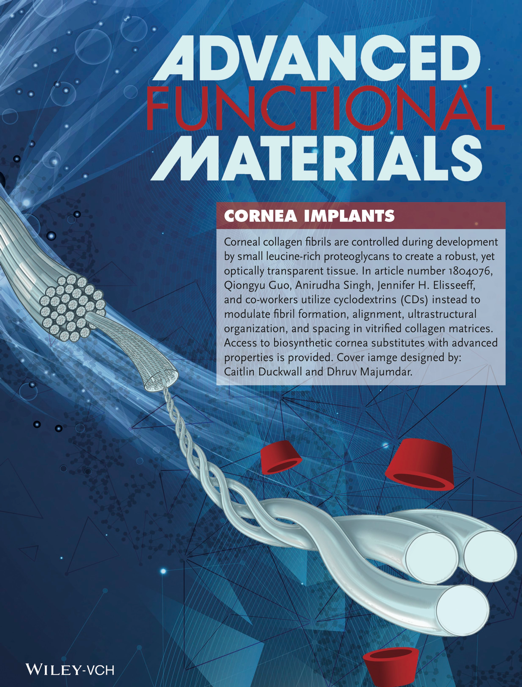Recently, Assistant Professor Qiongyu Guo from the Department of Biomedical Engineering at the Southern University of Science and Technology (SUSTech) published her implantable artificial cornea work as a co-corresponding author in the world-class journal Advanced Functional Materials (impact factor, 13.325). The paper, “Cyclodextrin Modulated Type I Collagen Self-Assembly to Engineer Biomimetic Cornea Implants”, was highlighted as a Frontispiece article in the journal (Figure 1) and has been highly evaluated in the report, “Organic, Transparent, but Robust- Biomimetic Cornea Implants”, in the Advanced Science News (see link below).

The worldwide demand for corneal transplantations cannot be matched by the supply of donor corneas, especially in most developing countries. Globally, unilateral corneal blindness is estimated to affect about 23 million people and bilaterally corneal blindness occurs in approximately 4.9 million people. However, each year less than 100 thousand corneal patients can get access to donor corneas to have their sight restored. Therefore, there is a large need of developing biosynthetic corneal substitute mimicking the native cornea in terms of optical, biomechanical and biological properties.
Prof. Qiongyu Guo with Assistant Professor Anirudha Singh, and Jennifer H. Elisseeff, a member of the American Academies of Engineering and Medicine, from the Johns Hopkins University reported a success control of collagen nanoarchitectures using proteoglycan analogs to form biomimetic corneal implant (figure 2).
Collagen‐rich cornea exhibit unique and highly organized extracellular matrix ultrastructures, which contribute to its high load‐bearing capacity and light transmittance. Corneal collagen fibrils are controlled during development by small leucine‐rich proteoglycans (SLRPs) that regulate the fibril diameter and spacing. However, obtaining purified proteoglycans has been a challenging task due to their high cost. Prof. Guo and co-workers discovered that cyclodextrins (CDs) could serve as proteoglycan analogs to facilitate the formation of collagen lamellar fibrillar structures similar to the native cornea. They developed facile biosynthetic methods and simultaneously improved both mechanically robust and optical transparency of the CD-collagen matrix, which offers a new route to fabricate collagen-based corneal substitute for corneal repair.

Original paper: https://onlinelibrary.wiley.com/doi/abs/10.1002/adfm.201804076
Link to the frontispiece: https://onlinelibrary.wiley.com/doi/abs/10.1002/adfm.201870297
News report: https://www.advancedsciencenews.com/organic-transparent-but-robust-biomimetic-cornea-implants/
Proofread ByXia Yingying
Photo By